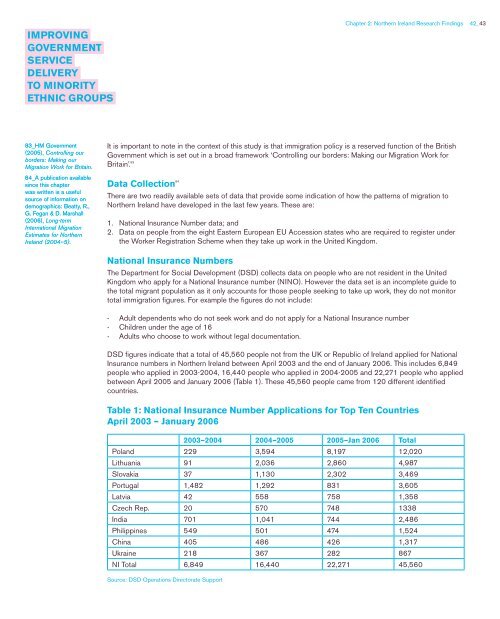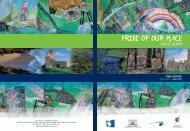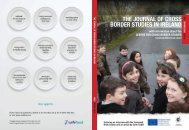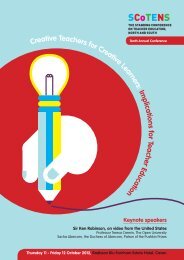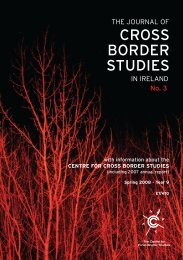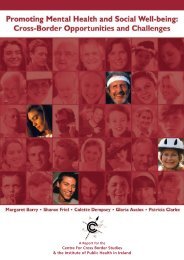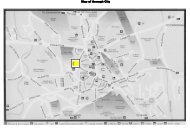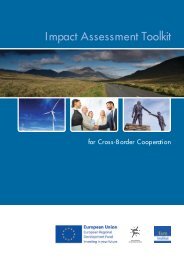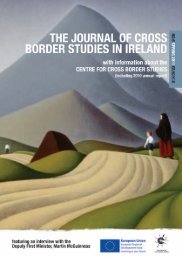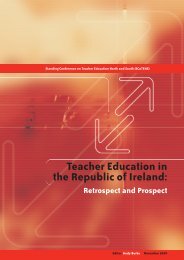improving government service delivery to minority ethnic ... - NCCRI
improving government service delivery to minority ethnic ... - NCCRI
improving government service delivery to minority ethnic ... - NCCRI
You also want an ePaper? Increase the reach of your titles
YUMPU automatically turns print PDFs into web optimized ePapers that Google loves.
<strong>improving</strong><br />
<strong>government</strong><br />
<strong>service</strong><br />
<strong>delivery</strong><br />
<strong>to</strong> <strong>minority</strong><br />
<strong>ethnic</strong> groups<br />
Chapter 2: Northern Ireland Research Findings 42_43<br />
83_HM Government<br />
(2005), Controlling our<br />
borders: Making our<br />
Migration Work for Britain.<br />
84_A publication available<br />
since this chapter<br />
was written is a useful<br />
source of information on<br />
demographics: Beatty, R.,<br />
G. Fegan & D. Marshall<br />
(2006), Long-term<br />
International Migration<br />
Estimates for Northern<br />
Ireland (2004–5).<br />
It is important <strong>to</strong> note in the context of this study is that immigration policy is a reserved function of the British<br />
Government which is set out in a broad framework ‘Controlling our borders: Making our Migration Work for<br />
Britain’. 83<br />
Data Collection 84<br />
There are two readily available sets of data that provide some indication of how the patterns of migration <strong>to</strong><br />
Northern Ireland have developed in the last few years. These are:<br />
1. National Insurance Number data; and<br />
2. Data on people from the eight Eastern European EU Accession states who are required <strong>to</strong> register under<br />
the Worker Registration Scheme when they take up work in the United Kingdom.<br />
National Insurance Numbers<br />
The Department for Social Development (DSD) collects data on people who are not resident in the United<br />
Kingdom who apply for a National Insurance number (NINO). However the data set is an incomplete guide <strong>to</strong><br />
the <strong>to</strong>tal migrant population as it only accounts for those people seeking <strong>to</strong> take up work, they do not moni<strong>to</strong>r<br />
<strong>to</strong>tal immigration figures. For example the figures do not include:<br />
-<br />
-<br />
-<br />
Adult dependents who do not seek work and do not apply for a National Insurance number<br />
Children under the age of 16<br />
Adults who choose <strong>to</strong> work without legal documentation.<br />
DSD figures indicate that a <strong>to</strong>tal of 45,560 people not from the UK or Republic of Ireland applied for National<br />
Insurance numbers in Northern Ireland between April 2003 and the end of January 2006. This includes 6,849<br />
people who applied in 2003-2004, 16,440 people who applied in 2004-2005 and 22,271 people who applied<br />
between April 2005 and January 2006 (Table 1). These 45,560 people came from 120 different identified<br />
countries.<br />
Table 1: National Insurance Number Applications for Top Ten Countries<br />
April 2003 – January 2006<br />
2003–2004 2004–2005 2005–Jan 2006 Total<br />
Poland 229 3,594 8,197 12,020<br />
Lithuania 91 2,036 2,860 4,987<br />
Slovakia 37 1,130 2,302 3,469<br />
Portugal 1,482 1,292 831 3,605<br />
Latvia 42 558 758 1,358<br />
Czech Rep. 20 570 748 1338<br />
India 701 1,041 744 2,486<br />
Philippines 549 501 474 1,524<br />
China 405 486 426 1,317<br />
Ukraine 218 367 282 867<br />
NI Total 6,849 16,440 22,271 45,560<br />
Source: DSD Operations Direc<strong>to</strong>rate Support


